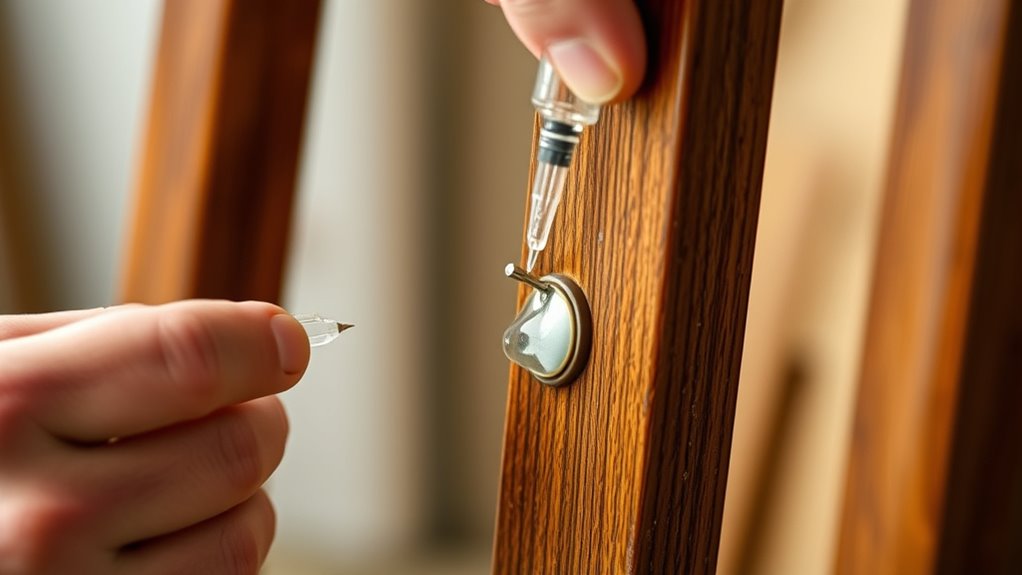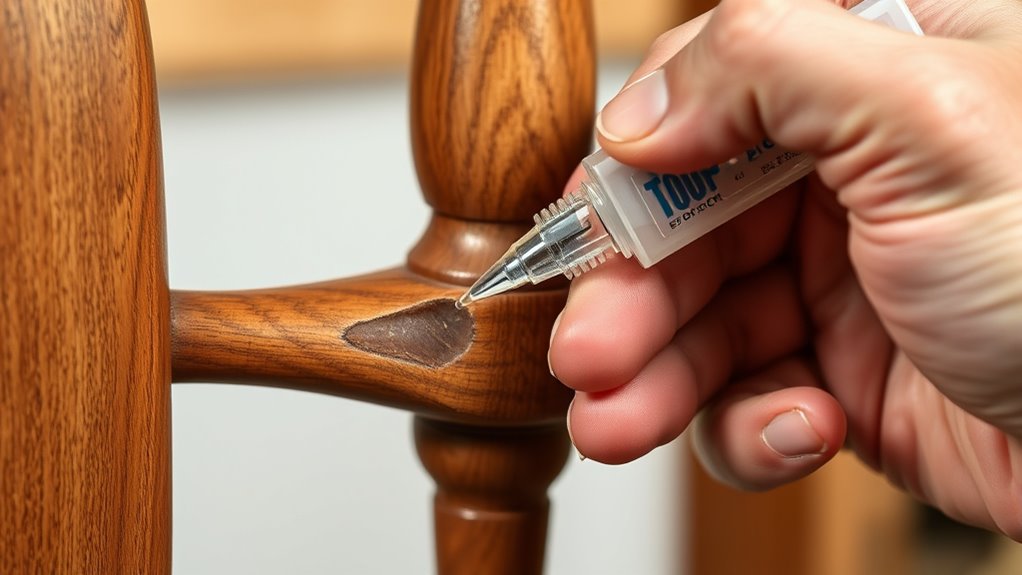To quickly fix loose chair rungs, start by cleaning the joint area thoroughly, then carefully inject a suitable wood epoxy into the space between the rung and leg or seat using a syringe or small applicator. Wipe away excess before it hardens, and secure the rung with clamps until the epoxy cures, usually within 24 hours. Proper application guarantees a sturdy fix that lasts. Want to discover more tips and tricks? Keep exploring this simple repair method.
Key Takeaways
- Identify loose rungs, clean joint areas, and select appropriate epoxy for wood repair.
- Inject epoxy carefully into the joint using a syringe, filling gaps without overfilling.
- Gently press or wiggle the rung to help epoxy settle and ensure maximum contact.
- Clamp or secure the rung temporarily and allow epoxy to cure fully, typically within 24 hours.
- Remove excess epoxy before it hardens for a clean finish, ensuring a durable, long-lasting repair.

Loose chair rungs can be a quick fix if you act fast. When your chair becomes wobbly or unstable, it’s often because the rungs have loosened from the legs or seat. Instead of replacing the entire chair or undertaking complex repairs, you can use simple wood repair techniques with epoxy to restore stability. Injected epoxy is an effective method because it seeps into cracks and gaps, creating a strong bond that holds everything firmly in place.
Loose chair rungs can be fixed quickly with epoxy, restoring stability without replacing the entire chair.
First, identify which rungs are loose and determine how much movement they have. Clean the area around the joint thoroughly, removing any dust, old glue, or debris that could interfere with adhesion. Once the area is clean, you’ll want to select a good epoxy designed for wood repair. These epoxies are formulated to bond with wood fibers and provide durability, making them perfect for fixing loose rungs. Mix the epoxy according to the manufacturer’s instructions, ensuring you have a uniform consistency that can be easily injected.
Next, use a syringe or a small applicator to inject the epoxy directly into the joint between the rung and the leg or seat. Be careful not to overfill; just enough to fill the gaps and ensure a tight bond. As you inject, you might notice a small amount of epoxy oozing out—this is a good sign that you’ve filled the space properly. After injecting, gently press or wiggle the rung to help the epoxy settle and ensure it makes maximum contact with the surrounding wood fibers.
Once all loose rungs have been treated, wipe away any excess epoxy before it hardens. Clamp or secure the rung temporarily if needed, to maintain pressure while the epoxy cures. Most epoxy adhesives reach full strength within 24 hours, but curing times can vary depending on the product. During this period, keep the chair in a stable position, avoiding use or weight on it to allow the epoxy to set fully.
This simple wood repair method with epoxy techniques is fast, efficient, and cost-effective. It’s ideal for restoring loose rungs without damaging the original structure or aesthetics of your chair. When done correctly, it provides a durable fix that can last for years. Plus, it’s a great skill to have for other furniture repairs around the house. Just remember to choose the right epoxy, follow the instructions, and give the repair ample time to cure. With these steps, your chair will be sturdy and stable once again, ready for regular use. Using Glycolic Acid in your skincare routine can also help improve the overall appearance of your skin, making your furniture repairs even more satisfying with a fresh look.
Frequently Asked Questions
Can This Method Be Used on Antique or Fragile Chairs?
You should be cautious with this method on antique preservation or fragile material. Injected epoxy can sometimes damage delicate wood or original finishes, risking further harm. For antique or fragile chairs, it’s better to consult a professional or use more gentle repair techniques that preserve the integrity and value of the piece. This approach guarantees you don’t unintentionally compromise the chair’s historical or delicate qualities.
How Long Does the Epoxy Take to Fully Cure?
You wonder about the drying time and curing process for epoxy. Typically, epoxy takes about 24 hours to fully cure, but this can vary depending on the product and environmental conditions. During the curing process, it’s important to keep the area undisturbed to guarantee maximum strength. Be patient and follow the manufacturer’s instructions closely, as proper curing is essential for a strong, durable repair.
Is Special Equipment Needed for Injecting Epoxy Into Rungs?
You won’t believe how simple it is to fix loose chair rungs with epoxy injection! No fancy repair equipment is necessary—just a syringe or small applicator tip works perfectly. You just need to carefully inject the epoxy into the joint, ensuring it fills every gap. This straightforward method makes repairs quick and effective, so you can get your chair sturdy again without hassle or specialized tools.
Will the Epoxy Affect the Chair’S Original Finish or Appearance?
You might wonder if epoxy affects your chair’s finish or appearance. Generally, if you choose a finish-compatible epoxy, it won’t harm the original look. However, some epoxies can cause slight aesthetic impacts, like color changes or sheen differences. To minimize this, select a clear, compatible epoxy and apply it carefully. This way, you preserve the chair’s original finish while securely fixing loose rungs.
How Durable Is This Repair Under Heavy Use or Weight?
You might worry that the repair won’t hold under heavy use, but epoxy’s load bearing capacity makes it surprisingly strong. During longevity testing, it withstands significant stress, ensuring your chair stays secure. This method creates a durable bond that resists loosening over time, even with frequent or heavy use. So, you can trust that your fix will hold up, providing a stable and lasting solution for your chair’s rungs.
Conclusion
Next time your chair feels wobbly, try this quick fix with injected epoxy. Imagine sitting comfortably again, just like Sarah did when her old wooden chair’s rungs started coming loose. She injected epoxy into the joints and let it cure overnight. The next day, her chair was as sturdy as new, and she avoided buying a replacement. With this simple repair, you can save money and extend your furniture’s life—no fuss needed.









